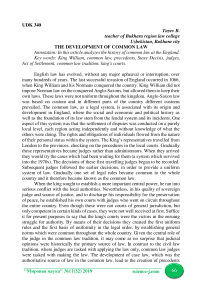The development of common law
Автор: Tuyev B.
Журнал: Мировая наука @science-j
Рубрика: Основной раздел
Статья в выпуске: 11 (32), 2019 года.
Бесплатный доступ
In this article analyzes the history of common law at the England.
King william, common law, precedents, stare decisis, judges, act of settlement, common law tradition, king's courts
Короткий адрес: https://sciup.org/140264076
IDR: 140264076 | УДК: 340
Текст научной статьи The development of common law
When the king sought to establish a more important central power, he ran into serious conflict with the local authorities. Nevertheless, in his quality of sovereign judge and source of justice, and to discharge his responsibility for the preservation of peace, he established his own courts with judges who went on circuit throughout the entire country. Even though these were not courts of general jurisdiction, but only competent in certain kinds of cases, they were not well received at first. Suffice it for present purposes to say that the king's courts were the victors in the ensuing struggle for authority. By means of their decisions they created the first uniform rules and the first basis of uniformity in the legal order, by establishing general norms which were common throughout the whole country. Given the central role of the judge in the common law tradition, it may come as no surprise that judicial opinions were historically the primary source of law. In contrast to the civil law tradition, where judges are tasked with applying the law only, common law judges were tasked with making the law. The development of case law, which was the authoritative source of law in the common law, lead to the creation of precedents and a system called Stare Decisis in order to ensure certainty, fairness and consistency in the system. A “precedent” is “an adjudged case or decision of a court, considered as furnishing an example or authority for an identical or similar case afterwards arising or a similar question of law.” Stare Decisis is a principle that requires a judge to follow previously established precedents. This applies to precedents established by higher courts. A higher court will not be bound to follow the precedent of a lower court even where the facts are identical (although the higher court may choose to). Laws or statutes were viewed as a secondary source of law, their role being to correct judicially-created rules. In 1701, the Act of Settlement created an independent judiciary. After this, Blackstone, an eminent legal scholar, published his “Commentaries on the Laws of England”, which were carried to colonies and also influenced the development of American law.
Today, legislation is far more central in common law countries. In the twentieth and twenty-first centuries, the common law underwent a crisis due to the modern trend to use the law to create new social order: the case-by-case method is not well suited to the idea of bringing about rapid and extensive social change. The common law influence spread to countries like Australia, Canada, South Africa, New Zealand, India, Zimbabwe, Ghana, Sierra Leone, Gambia, Nigeria, Somalia, Tanzania, Uganda, Kenya, Zambia, Botswana, Malawi, and many Caribbean islands.
Список литературы The development of common law
- www.jstor.org//Joseph Dainow. The Civil Law and the Common Law: Some Points of Comparison. The American Journal of Comparative Law, Vol. 15, No. 3 (1966 - 1967), pp.
- Merryman, The Civil Law Tradition, 164.
- Warren, Introduction to the Major Legal Systems.
- Blacks Law Dictionary, (6th Edition), (West Publishing Co, St. Paul, Minnesota) (1991), pg. 814.


